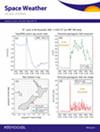The Daytime Variations of Thermospheric Temperature and Neutral Density Over Beijing During Minor Geomagnetic Storm on 3–4 February 2022
IF 3.7
2区 地球科学
引用次数: 0
Abstract
On 3 February 2022, 38 satellites launched by SpaceX re-entered the atmosphere and were subsequently destroyed. An investigation found that a minor geomagnetic storm occurred on 3–4 February 2022 led to a neutral density enhancement and large atmospheric drag. To better understand the responses of the thermosphere to geomagnetic storms, the method proposed by Li et al. (2023, https://doi.org/10.1029/2022ja030988) was employed to extract exospheric temperature (Tex) from ionosonde electron density profiles (∼150–200 km) in Beijing (geolocation: 39.56°N; 116.2°E; geomagnetic location: 30.16°N; 172.08°W) station. The retrieved Tex was plugged into the NRLMSISE-00 model to calculate the corresponding neutral density. Derived results showed a ∼2%–7% enhancement in Tex and a ∼15%–38% enhancement in neutral density at 430 km. The relative deviation in neutral density on the satellites’ orbital trajectory ranges from ∼10% (210 km) to ∼35% (500 km) on 3 February, and from ∼13% (210 km) to ∼60% (500 km) on 4 February. Furthermore, the neutral density reproduced the variations observed by the SWARM-C satellite fairly well both on quiet and disturbed days. These results suggest that even a minor geomagnetic storm can cause significant changes in neutral temperature and neutral density at middle latitudes. Additionally, the application of our inversion method, combined with the global, long-term and real-time ionospheric observations from ionosondes, provides an opportunity to improve the capability of thermosphere forecasting and nowcasting.2022 年 2 月 3-4 日小地磁风暴期间北京上空热层温度和中性密度的昼间变化
2022 年 2 月 3 日,SpaceX 发射的 38 颗卫星重返大气层,随后被摧毁。调查发现,2022 年 2 月 3-4 日发生的小规模地磁暴导致中性密度增强和大气阻力增大。为了更好地了解热层对地磁暴的响应,采用了 Li 等人(2023 年,https://doi.org/10.1029/2022ja030988)提出的方法,从北京(地理位置:39.56°N;116.2°E;地磁位置:30.16°N;172.08°W)站的电离层电子密度剖面图(∼150-200 公里)中提取大气层外温度(Tex)。检索到的 Tex 输入 NRLMSISE-00 模型,以计算相应的中性密度。推导结果表明,在 430 公里处,Tex 增强了 2%-7%,中性密度增强了 15%-38%。卫星轨道上中性密度的相对偏差在 2 月 3 日为 10%(210 公里)到 35%(500 公里),在 2 月 4 日为 13%(210 公里)到 60%(500 公里)。此外,中性密度相当好地再现了SWARM-C卫星在平静和扰动日观测到的变化。这些结果表明,即使是轻微的地磁暴也能引起中纬度地区中性温度和中性密度的显著变化。此外,我们的反演方法与电离层探测仪的全球、长期和实时电离层观测相结合,为提高热层预报和现报能力提供了机会。
本文章由计算机程序翻译,如有差异,请以英文原文为准。
求助全文
约1分钟内获得全文
求助全文

 求助内容:
求助内容: 应助结果提醒方式:
应助结果提醒方式:


